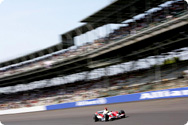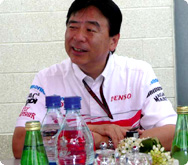Grand Prix > 2007 Grand Prix > United States Grand Prix > Review
|
|
19 Jun,2007 (Tue)
As always, thank you for your support over the weekend. Here is my report from the U.S. GP, the second race of the North American Round in as many weeks, held at the holy land of American auto sports, the Indianapolis Motor Speedway.
 Despite troubles with the right front suspension upright at the Canadian GP last week, the difference in characteristics between the Indianapolis and Montreal circuits meant that Panasonic Toyota Racing were able to use the same upright specification as the one used in Canada. There were no significant changes introduced to the TF107 between the two races.
Despite troubles with the right front suspension upright at the Canadian GP last week, the difference in characteristics between the Indianapolis and Montreal circuits meant that Panasonic Toyota Racing were able to use the same upright specification as the one used in Canada. There were no significant changes introduced to the TF107 between the two races.High expectations for Indianapolis based on our good performance last year
At the Canadian GP last week, we had trouble with the uprights on Jarno's (Trulli) car, preventing us from finding a satisfactory setup prior to qualifying, and continuing on to negatively impact our race pace. While a one-stop strategy was implemented by one of the teams that made it to the podium, we hadn't been able to test long runs on both types of tires during Friday practice, making it difficult for us to determine how stable of a performance we could expect from the super-soft tires during race conditions. This was one factor that kept us from gambling on a one-stop race. A series of unfortunate events made for disappointing results at the Canadian GP, but last year at the Indianapolis circuit, Jarno rode a one-stop strategy to capture P4. Ralf (Schumacher) was running P5 in last year's race until his car experienced bearing troubles during the third stint. We had great expectations for more great performances from our drivers coming into this year's U.S. GP.
The best result was having both cars completing Friday's programs were the greatest yield
For the first time in a long time, we had a trouble-free Friday practice, and we were able to complete the entire first day's program exactly as planned. Usually, we would expect nothing less, but at the Monaco GP, for example, the water pipes in the second floor of our garage broke, flooding the first floor, and preventing us from being able to use our telemetry during the free practice session. At the Canadian GP, trouble with breaking uprights forced us to go into qualifying without a fully established car setup. In that sense, being able to finally complete a full program on Friday meant that we could go into Saturday morning practice to concentrate on car settings for qualifying based on a full set of long run data.
We brought two sets of uprights with us to the U.S. GP: one set of the same specification that gave us trouble last week in Canada, and another set designed to a stronger specification. Indianapolis didn't have the same crossties behind the curbs that were in Montreal, but we checked the load on the uprights when we first started lapping at the Motor Speedway. After confirming that there was no problem here, we decided to use the same upright spec that we used in Canada.
While our lap times might have seemed fairly far down on the time chart, this was mainly due to the fact that we put on new tires rather early, so we weren't especially concerned about our pace. Of course, both drivers suffered from lack of grip during the first day, but we were able to make grip improvements on Saturday. Overall, I would have to say it was a favorable first day of the grand prix weekend.
Disappointment that only one car made the third period, but expectations for Ralf's resurgence
 Ralf's time during the second qualifying session was only 0.1 seconds behind Jarno's 10th-place time, but that marked the borderline between dropping out and continuing on to the final session. Ralf qualified P12, but showed signs of being able to move up through the field on race day.
Ralf's time during the second qualifying session was only 0.1 seconds behind Jarno's 10th-place time, but that marked the borderline between dropping out and continuing on to the final session. Ralf qualified P12, but showed signs of being able to move up through the field on race day.But we had such high expectations for both cars to qualify in the top 10 that we all felt some disappointment that Ralf wasn't able to continue on to the final qualifying period. I really can't point to any significant mistakes or traffic issues. I just think that the qualifying times were all so close that even minor mistakes resulted in large position differences. Even though he didn't make it past Q2, Ralf wasn't driving badly at all-even outpacing Jarno during Saturday's morning practice session. We thought that Ralf might qualify as the better of our two drivers on Saturday, and we still feel confident that Ralf has found his way back to performing at the level he wants. Although Ralf qualified P12, we had high expectations that he would battle his way through the field during Sunday's race.
Jarno captures P6; good ammunition going into the second half of the European Round
 Panasonic Toyota Racing had a late first pit stop compared to the other teams that went with a two-stop strategy. Having Jarno come in to the pits for his first stop on lap 31 worked well enough to let Jarno gain two positions, capturing three championship points for the team. The North American Round finished with Jarno and Ralf capturing three points and one point, respectively.
Panasonic Toyota Racing had a late first pit stop compared to the other teams that went with a two-stop strategy. Having Jarno come in to the pits for his first stop on lap 31 worked well enough to let Jarno gain two positions, capturing three championship points for the team. The North American Round finished with Jarno and Ralf capturing three points and one point, respectively. With an ambient temperature of 35°C and a track temperature of 50°C, Jarno fought heat and tire graining throughout the entire race. The team adopted a soft → soft → medium order for tire selection, accomplishing the goal of holding back the competition and finishing well within the points.
With an ambient temperature of 35°C and a track temperature of 50°C, Jarno fought heat and tire graining throughout the entire race. The team adopted a soft → soft → medium order for tire selection, accomplishing the goal of holding back the competition and finishing well within the points.Meanwhile, Ralf's brakes locked in the first corner immediately after the race start, bringing him into contact with another car. With a damaged front left suspension, Ralf was done for the day. Ralf had made it to Q2 for the first time in four races, barely missing out on making Q3. But even so, we were encouraged to see Ralf back at his former speed, which made the early retirement all the more disappointing. I do think, though, that Ralf's performance here will bring some good momentum into the next GP.
We still haven't closed the gap with the top teams, but we'll take four points away from the North American Round as a worthwhile souvenir, working harder than ever on further development as we go into the rest of the European Round. We at Panasonic Toyota Racing ask for your continued valued support.

Noritoshi Arai, watching Panasonic Toyota Racing capture their best finish of the season so far in Indianapolis. After testing at Silverstone, the team will head to the French GP, aiming for a double-points finish.